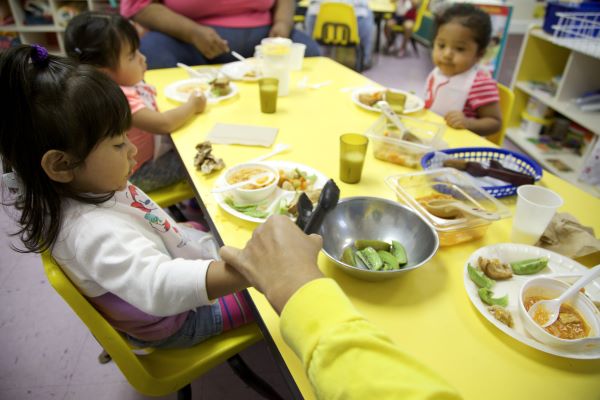 Setting up snack and mealtimes as learning opportunities — to support staff-child interactions and encourage conversations — contribute to a child’s learning, development, and social skills.
Setting up snack and mealtimes as learning opportunities — to support staff-child interactions and encourage conversations — contribute to a child’s learning, development, and social skills.
Setting up positive eating environments is an important way to help children learn healthy eating habits. These efforts may lead to improved nutrition intake, consistent mealtime routines, and increased awareness among children about nutritious foods. Putting policies and practices into place can help guide and reinforce a commitment to creating positive mealtime environments.
Responsive feeding is an approach that gives responsibility for meals and snacks to both the caregiver and the child. The caregiver prepares the food and encourages children to eat on their own and in response to their physical and developmental needs. Staff should never use food as a reward or punishment or force children to eat or finish all the food on their plate. This fosters self-regulation in eating by giving children control over what, when, or how much they eat. It also encourages cognitive, emotional, and social development. Children benefit from feeding environments when adults acknowledge their signs of hunger and satisfaction with prompt, supportive, and developmentally appropriate responses. When children have some control over their meals, they are more likely to eat when they are hungry and stop eating when they are full. The division of responsibility starts in infancy and changes as the child grows and develops their own food preferences.
Family-style dining in early childhood programs is when children and teachers sit together at a table for a meal or snack. It helps children make good food choices by seeing positive attitudes from teachers and peers. Staff model and encourage learning by giving children opportunities to try new foods and introduce language and concepts about food. Young children learn how to use eating and serving utensils and help to set and clean the table. Other benefits include new motor skills and more social skills. Children can best practice these skills and enjoy their food when programs give them enough time to eat.
Tips and Strategies for Child Feeding Practices
- Support staff in carrying out each part of the nutrition program, including family-style dining.
- Promote mealtime as a positive learning experience engaging staff and children.
- Review the Positive Eating Environment Self-assessment for ECE Programs.
- Consider an assessment of basic mealtime practices in classrooms and family child care homes serving 3- to 5-year-olds.
- Make responsive feeding a part of your program’s culture and environment.
- Encourage staff to read the feeding cues of the children they are caring for.
Learn More
Read more:
Resource Type: Article
National Centers: Health, Behavioral Health, and Safety
Audience: Directors and Managers
Last Updated: December 1, 2023